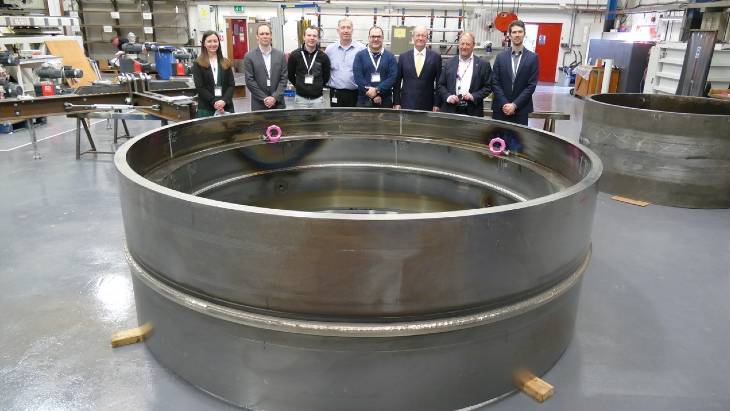The weld, equivalent to approximately 10 metres of length, was completed in 140 minutes. The company said such a weld would normally take months and include various stages of non-destructive testing as well as heat treatment.
Professor Jesus Talamantes-Silva, research, design and technology director, said: "This is the most critical milestone in our project to industrialise EBW and to eliminate the requirement for large vacuum chambers typically used in this technology, we have pioneered the use of local vacuum EBW alongside our project partners, Cambridge Vacuum Engineering (CVE).
"This follows a body of work started in 2015 with support from Innovate UK to establish the basic science for local vacuum EBW, which was successful, producing welds with very favourable mechanical properties."
The EBW process uses local vacuum and a high-power electron gun which penetrates the vessel material with an electron beam, to melt and fuse the two components together in one go, rather than building up multiple layers of weld filler wire.
An industry steering committee including the Ministry of Defence, Rolls-Royce submarines and SMR divisions, the UK Atomic Energy Authority and Cavendish Nuclear, was formed to ensure awareness of EBW technology within the context of the UK’s civil nuclear power plans. Engagement from the Office for Nuclear Regulation (ONR) and the Environment Agency (EA) was also instigated by the Department for Business, Energy and Industrial Strategy (BEIS).
Senior Development Engineer and Project Lead Michael Blackmore said: "We completed the weld and carried out the factory acceptance testing of the machine tool, a process that verifies that the equipment is built and operating in accordance with design specifications at CVE's site in Cambridge.
"We are due to start building an X-Ray enclosure to house the EBW equipment, and it will be ready during Q2 2022. We are also planning to fully demonstrate the welding capabilities by fabricating a full-scale nuclear pressure vessel which will consist of five main components, four shells and a nuclear head, to ensure a reliable and repetitive process."
CVE Managing Director Bob Nicolson said: "We have been proud to host the ONR, EA and BEIS representatives during visits to our Cambridge factory to officially present progress and hardware capabilities to be utilised at Sheffield Forgemasters."
The project was part funded under the GBP26 million (USD34 million) Advanced Manufacturing and Materials Programme within the BEIS Energy Innovation Programme.
Recent media reports suggest that in the forthcoming energy strategy UK Prime Minister Boris Johnson will set out a plan for the country to get 25% of its electricity from nuclear power, up from the current 16%. A key part of this expansion is expected to be SMRs - earlier this month BEIS requested the ONR and the environment regulators for England and Wales begin a Generic Design Assessment for Rolls-Royce SMR Limited’s small modular reactor design.
The Rolls-Royce-led UK SMR consortium aims to build 16 SMRs, including up to 10 by 2035.






_18570.jpg)
_16159.jpg)
_49205.jpg)





